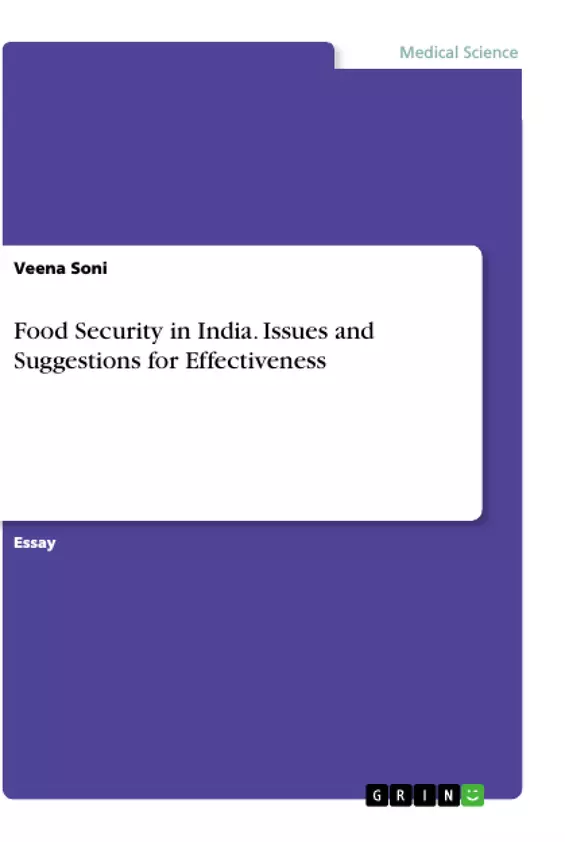Attaining food security is a matter of prime importance for India where more than a third of its population is estimated to be absolutely poor, and as many as one half of its children have suffered from malnourishment over the last three decades. Several important issues have emerged in the context of food security in India. These have been (a) the liberalization of the economy and its impact on agriculture and food security; (b) the establishment of the WTO and the agreement on Agriculture; (c) climate change and its impact on food production and prices; (d) the prevalence of hunger and poverty coexisting with high levels of food stocks; (e) the introduction of the targeted Public Distribution System (f) the "Right to Food" campaign; and (g) the National Food Security Bill. These important issues have posed severe challenges for food security in the country.
The Food and Agricultural Organization (FAO) states that food security emerges when all people at all times have physical and economic access to sufficient, safe and nutritious food to meet their dietary needs and food preferences for an active and healthy life. Food security has three important and closely related components, which are availability of food, access to food, and absorption of food.
Food security is thus a multi-dimensional concept and extends beyond the production availability, and demand for food. There has been a definite and significant paradigm shift in the concept of food security from mere macro level availability and stability to micro level household food insecurity, and also from an assessment of energy intake to measures and indicators of malnutrition.
Inhaltsverzeichnis (Table of Contents)
- FOOD SECURITY IN INDIA: A BRIEF OVERVIEW
- FOOD SECURITY IN INDIA: ISSUES AND SUGGESTIONS FOR EFFECTIVENESS
- THE AVAILABILITY OF FOOD
- The Status and Trends in Food Production and Availability
- Major Factors Responsible for Decline in Food Production
Zielsetzung und Themenschwerpunkte (Objectives and Key Themes)
This document aims to provide a comprehensive analysis of food security in India, examining both the achievements and challenges faced in ensuring adequate food availability, access, and utilization for the nation's population. It explores the historical context of food security in India, particularly focusing on the impact of the Green Revolution. The document then delves into key issues impacting food security, including the liberalization of the economy, the establishment of the WTO, climate change, and the prevalence of hunger amidst high food stock levels. It also discusses the role of government policies, such as the Public Distribution System, the Right to Food campaign, and the National Food Security Bill.
- Food Security in India
- Impact of Economic Liberalization on Agriculture and Food Security
- Challenges of Climate Change and Its Effect on Food Production
- Addressing Hunger and Malnutrition Despite Ample Food Stocks
- The Importance of Food Distribution and Access for Household Food Security
Zusammenfassung der Kapitel (Chapter Summaries)
Chapter 1, "Food Security in India: A Brief Overview," reviews the history of food security in India, particularly highlighting the Green Revolution's role in transforming the nation from a food deficit to a food-sufficient country. It discusses the positive impact of the Green Revolution on food production and its subsequent contributions to reducing poverty and improving dietary energy supply. The chapter also examines the challenges, such as the prevalence of malnutrition despite overall food security at a macro level.
Chapter 2, "Food Security in India: Issues and Suggestions for Effectiveness," examines the factors contributing to the decline in food production, including the impact of economic liberalization, climate change, and the challenges of ensuring equitable access to food despite sufficient stock levels. It explores the effectiveness of various government initiatives, such as the Public Distribution System, the Right to Food campaign, and the National Food Security Bill, in addressing food insecurity.
Chapter 2 also delves into the concept of food security, its multi-dimensional aspects, and the various types of food insecurity. It explores the supply and demand-side factors influencing food security, highlighting the need for efficient food production, distribution, and social programs to ensure access and absorption of food.
Chapter 2 further analyzes the availability of food in India, examining the performance of domestic food production and import policies. It explores the factors responsible for the declining growth rate in food production, including land degradation, water stress, and shrinking farm sizes. The chapter also emphasizes the importance of sustainable agricultural practices for ensuring future food security.
Schlüsselwörter (Keywords)
The main keywords and focus topics of this work include food security, agriculture, India, Green Revolution, economic liberalization, WTO, climate change, hunger, malnutrition, Public Distribution System, Right to Food, National Food Security Bill, household food security, food availability, access, and absorption.
- Quote paper
- Dr. Veena Soni (Author), 2020, Food Security in India. Issues and Suggestions for Effectiveness, Munich, GRIN Verlag, https://www.hausarbeiten.de/document/593460


